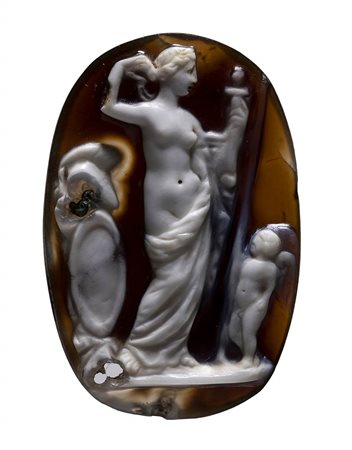 Bertolami Fine Art - Bertolami Fine Art, 1 Harewood Place 1, W1S 1BU Londra
Bertolami Fine Art - Bertolami Fine Art, 1 Harewood Place 1, W1S 1BU Londra
ASTA 107 - Glittica Sessione Unica
Friday 22 April 2022 hours 15:00 (UTC +00:00)
A very fine roman sardonyx cameo. Venus Victrix. 1st century B.C. - 1st century A.D.
A very fine roman sardonyx cameo. Venus Victrix.
1st century B.C. - 1st century A.D.
The divinity is standing, facing right, with the head in profile and the body slightly in three quarters. The right arm is raised, in the act of wearing over the shoulder the sheath strap (belt) that support the sword. With her left hand she holds the sword. The upper part of the body is naked, leaving the beautiful torso uncovered up to the pubis; the tunic covers the legs leaving the feet uncovered, the right one seen from the front and the left one in profile. The pose is of great elegance. The anatomical details and the drapery are engraved with great mastery. The model is inspired by hellenistic Greek models. The figure rests on a thick groundline. On the right, facing the deity, is a winged erote holding the spear (Amor). To the left of the scene, a helmet over a shield. Allegory of the victorious love. The goddess of beauty arms herself with the weapons of Mars, god of war, with the help of Love. The scene is sculpted on a two-layered sardonyx of exceptional beauty, characterized by a white layer and a variegated honey-colored background with more brownish areas, transparent or dark inclusions (Murrina). The stone has small holes of natural origin (mineral). The raised right forearm is characterized by a darker part which is not a defect but an inclusion. A part from the small lacks of natural origin, the gem has only slight micro cracks on the edge, not relevant. Chip on the back of the stone, that is miraculously remained intact despite the very thin thickness, and the large size that makes it even more fragile. A work of great rarity. A very close comparison comes from the Grand Ducal collections (Florence, Medici collection) with an onyx cameo with Venus Victrix in a very similar pose and stylistic rendering. This cameo in Florence, without the Eros, in 1786 described Venus "che si cava la cintura, a cui è appeso un parazzonio, e che ha ai piedi uno scudo antico (sic)"; 1799: Venere stante seminuda con allato lo scudo argolico in atto di cavarsi il brodiero da cui pende il parazonio quale si vede in una statua del Museo Borghesiano", interesting for the marble model (coll. Borghese); 1862: Venere Vincitrice. Giulio Cesare, rampollo di una Famiglia che nella sua genealogia risaliva a Venere, ed insieme prode ed invitto generale d'invitti soldati, con molta giustizia adottò il costume spartando vestendo delle armi la madre d'Amore, e facendo a ciò alludere il nome di Venere Vincitrice..... deposto lo scudo si toglie il telamone, al quale è appeso il parazonio ch'ella sostiene colla sinistra". Parallel: A. Giuliano, I Cammei dalla Collezione Medicea, del Museo Archeologico di Firenze, p. 154 n. 29.
19x22x3 mm






